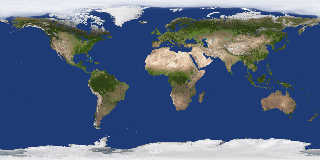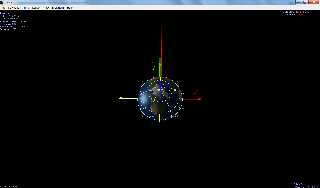 |
 |
|
 |
|
 |
|  |
|  |
|
 |
|
 |
|  |
|  |
|
 |
Am 15.09.2018 um 22:12 schrieb Bald Eagle:
>> "Modulos the mean anomaly so that -180 <= M <= +180 ..."
...
> I do believe that this is typically done with a macro, and occurs in the POV-Ray
> source code.
>
> #macro Modulate (_X)
> #while (_X < 180) #local _X = _X+360; #end
> #While (_X > 180) #local _X = _X-360; #end
> _X
> #end
That would be way too time-consuming for very large or very small values.
> Then of course, there's
> http://www.povray.org/documentation/view/3.6.2/458/
>
> clamp(V, Min, Max). A function that limits a value to a specific range, if it
> goes outside that range it is "clamped" to this range, wrapping around. As the
> input increases or decreases outside the given range, the output will repeatedly
> sweep through that range, making a "sawtooth" waveform.
> Parameters:
That'll indeed do it:
#include "math.inc"
#local Foo = clamp(M,-180,180);
Alternatively:
#local Foo = mod(M+180,360)-180;
#if (Foo < -180)
#local Foo = Foo + 260;
#end
The post-processing `#if` branch is necessary because mod(X,Y) wraps
positive values into the range [0..Y), but negative values into the
range (-Y..0].
[At least on platforms where converting a floating-point number to an
integer rounds towards 0. That's the case for all contemporary platform
I'm aware of, and is an official prerequisite for compiling POV-Ray, but
the C++ standard would also allow for rounding towards negative infinity
instead.]
`clamp()` effectively does the same, but is implemented as a function,
which probably makes it faster than a macro or "in-line" code.
Post a reply to this message
|
 |
|  |
|  |
|
 |
|
 |
|  |
|  |
|
 |
On 9/15/2018 4:12 PM, Bald Eagle wrote:
> clamp(V, Min, Max). A function that limits a value to a specific range, if it
> goes outside that range it is "clamped" to this range, wrapping around. As the
> input increases or decreases outside the given range, the output will repeatedly
> sweep through that range, making a "sawtooth" waveform.
> Parameters:
>
> V = Input value.
> Min = Minimum of output range.
> Max = Maximum of output range.
>
>
> Bill
>
>
Clamp works, thanks!
Mike
Post a reply to this message
|
 |
|  |
|  |
|
 |
|
 |
|  |
|  |
|
 |
https://ssd.jpl.nasa.gov/txt/aprx_pos_planets.pdf
I am a little confused about the "Solution of Kepler's Equation" on Page
2 of this document. Have I implemented it correctly do you think?
#local Orrery_Temp_EStar = 180/pi * Orrery_Temp_Eccentricity;
#local Orrery_Temp_EccentricAnomaly = Orrery_Temp_MeanAnomaly +
Orrery_Temp_EStar * sind(Orrery_Temp_MeanAnomaly);
#local Orrery_Temp_EccentricAnomalyTolerance = 10e-6;
#local Orrery_Temp_EccentricAnomalyDelta = 0;
#while (abs(Orrery_Temp_EccentricAnomalyDelta) >
Orrery_Temp_EccentricAnomalyTolerance)
#local Orrery_Temp_MeanAnomalyDelta = Orrery_Temp_MeanAnomaly -
(Orrery_Temp_EccentricAnomaly - Orrery_Temp_EStar *
sind(Orrery_Temp_EccentricAnomaly));
#local Orrery_Temp_EccentricAnomalyDelta =
Orrery_Temp_MeanAnomalyDelta/(1 - Orrery_Temp_Eccentricity *
cosd(Orrery_Temp_EccentricAnomaly));
#local Orrery_Temp_EccentricAnomaly = Orrery_Temp_EccentricAnomaly
+ Orrery_Temp_EccentricAnomalyDelta;
#end
Mike
Post a reply to this message
|
 |
|  |
|  |
|
 |
|
 |
|  |
|  |
|
 |
On 9/16/2018 3:00 PM, Mike Horvath wrote:
> https://ssd.jpl.nasa.gov/txt/aprx_pos_planets.pdf
>
> I am a little confused about the "Solution of Kepler's Equation" on Page
> 2 of this document. Have I implemented it correctly do you think?
>
> #local Orrery_Temp_EStar =
180/pi *
> Orrery_Temp_Eccentricity;
> #local Orrery_Temp_EccentricAnomaly =
> Orrery_Temp_MeanAnomaly + Orrery_Temp_EStar *
> sind(Orrery_Temp_MeanAnomaly);
> #local Orrery_Temp_EccentricAnomalyTolerance = 10e-6;
> #local Orrery_Temp_EccentricAnomalyDelta = 0;
> #while (abs(Orrery_Temp_EccentricAnomalyDelta) >
> Orrery_Temp_EccentricAnomalyTolerance)
> #local Orrery_Temp_MeanAnomalyDelta =
> Orrery_Temp_MeanAnomaly - (Orrery_Temp_EccentricAnomaly -
> Orrery_Temp_EStar * sind(Orrery_Temp_EccentricAnomaly));
> #local Orrery_Temp_EccentricAnomalyDelta =
> Orrery_Temp_MeanAnomalyDelta/(1 - Orrery_Temp_Eccentricity *
> cosd(Orrery_Temp_EccentricAnomaly));
> #local Orrery_Temp_EccentricAnomaly =
> Orrery_Temp_EccentricAnomaly + Orrery_Temp_EccentricAnomalyDelta;
> #end
>
>
>
> Mike
I did end up finding a bug in that code, but I also discovered that
there's not a visible difference with the code working or not working.
So the major problems I am having lie elsewhere.
:(
Mike
Post a reply to this message
|
 |
|  |
|  |
|
 |
|
 |
|  |
|  |
|
 |
I found the bug, and will be uploading a corrected version to the Object
Collection shortly.
Mike
Post a reply to this message
|
 |
|  |
|  |
|
 |
|
 |
|  |
|  |
|
 |
On 9/15/2018 1:07 PM, Mike Horvath wrote:
> I'm trying to adapt the following PDF to POV-Ray code for my
> planetarium/orrery.
>
> https://ssd.jpl.nasa.gov/txt/aprx_pos_planets.pdf
>
In Step 6 of that PDF, it gives an equation on how to convert between
ecliptic coordinates and J2000 coordinates.
What is the inverse of that equation, and how do I change it into a
series of `rotate` commands instead?
Thanks.
Mike
Post a reply to this message
|
 |
|  |
|  |
|
 |
|
 |
|  |
|  |
|
 |
On 9/20/2018 8:17 PM, Mike Horvath wrote:
> On 9/15/2018 1:07 PM, Mike Horvath wrote:
>> I'm trying to adapt the following PDF to POV-Ray code for my
>> planetarium/orrery.
>>
>> https://ssd.jpl.nasa.gov/txt/aprx_pos_planets.pdf
>>
>
> In Step 6 of that PDF, it gives an equation on how to convert between
> ecliptic coordinates and J2000 coordinates.
>
> What is the inverse of that equation, and how do I change it into a
> series of `rotate` commands instead?
>
> Thanks.
>
>
>
> Mike
I found the inverse on Wikipedia.
https://en.wikipedia.org/wiki/Ecliptic_coordinate_system#Conversion_between_celestial_coordinate_systems
Still not sure how to replace the equation with a series of `rotate`
commands though.
Mike
Post a reply to this message
|
 |
|  |
|  |
|
 |
|
 |
|  |
|  |
|
 |
Found a document with a table of values:
https://astropedia.astrogeology.usgs.gov/download/Docs/WGCCRE/WGCCRE2009reprint.pdf
The pertinent variables are alpha, delta and W. What do I do with these
variables? Dunno for sure. This document provides a formula:
https://depositonce.tu-berlin.de/bitstream/11303/6237/4/burmeister_steffi.pdf
I /think/ I need to rotate around the z-axis by W, around the x-axis by
(90-δ), and around the z-axis again by (90+α), in that order. Lastly, an
additional rotation (around the x-axis?) by 23.43928 degrees must be
done to get the body out of the ICRF frame and into the ecliptic frame.
But I still don't know the starting conditions. I.e. before applying the
transformations, should the globe's North Pole point upward? Should the
intersection of the Prime Meridian and Equator lie along the x-axis?
Also, am I wrong, and should I perform the inverse matrix calculations
instead? Either way, I have not gotten results that match what I see in
Celestia for the same Julian Date.
Mike
Post a reply to this message
|
 |
|  |
|  |
|
 |
|
 |
|  |
|  |
|
 |
Le 25/09/2018 à 07:39, Mike Horvath a écrit :
> Found a document with a table of values:
>
> https://astropedia.astrogeology.usgs.gov/download/Docs/WGCCRE/WGCCRE2009reprint.pdf
>
>
> The pertinent variables are alpha, delta and W. What do I do with these
> variables? Dunno for sure. This document provides a formula:
>
> https://depositonce.tu-berlin.de/bitstream/11303/6237/4/burmeister_steffi.pdf
>
Read start of 1.3, alpha, delta & W are defined there.
>
> I /think/ I need to rotate around the z-axis by W, around the x-axis by
> (90-δ), and around the z-axis again by (90+α), in that order.
W is the "day" part of the planet, adjusting the prime meridian.
Right-handed system, so, yes, W is for z-axis when applied first.
Otherwise, it would be applied along the rotation axis of the planet
once transformed from z by alpha & delta.
Figure 1.3 , page 11
From the point gamma on ICRF equator, starting sphere, the axis of
rotation of the planet is located at 90°+alpha, for an amount of
90°-delta. (a single tilting of the planet axis, along a single
perpendicular axis)
If I assert +x is gamma at start, +z north, you have to apply a rotation
along v_rotate( y, alpha*z) of 90°-delta, then a rotation of W along the
new pole axis.
You can of course transfer the W part before the other rotation, as it
is simpler to use z.
> Lastly, an
> additional rotation (around the x-axis?) by 23.43928 degrees must be
> done to get the body out of the ICRF frame and into the ecliptic frame.
That's a change of referential, the matrix should be well-known. (i.e. I
have no clue)
I do not know the x,y,z of ICRF(2) compared to the ecliptic plan and the
vernal point.
>
> But I still don't know the starting conditions. I.e. before applying the
> transformations, should the globe's North Pole point upward? Should the
> intersection of the Prime Meridian and Equator lie along the x-axis?
Yes. x2.
> Also, am I wrong, and should I perform the inverse matrix calculations
> instead? Either way, I have not gotten results that match what I see in
> Celestia for the same Julian Date.
>
>
> Mike
Post a reply to this message
|
 |
|  |
|  |
|
 |
|
 |
|  |
|  |
|
 |
Thanks for taking a look!
> Figure 1.3 , page 11
>
> From the point gamma on ICRF equator, starting sphere, the axis of
> rotation of the planet is located at 90°+alpha, for an amount of
> 90°-delta. (a single tilting of the planet axis, along a single
> perpendicular axis)
>
> If I assert +x is gamma at start, +z north, you have to apply a rotation
> along v_rotate( y, alpha*z) of 90°-delta, then a rotation of W along the
> new pole axis.
>
I can't quite understand your steps. Do you want me to do this?
#declare sphere_coo = vrotate(y, (90+alpha_0) * z);
#declare sphere_coo = vrotate(sphere_coo, (90-delta_0) * x);
OTOH, I have attached my scene so far if you would please look at it.
The result is not similar to what I see in the program Celestia for the
same Julian day. (I have attached a screenshot of that program as well.)
Mike
Post a reply to this message
Attachments:
Download 'do_not_delete.pov.txt' (5 KB)
Download '2k_earth_daymap.jpg' (453 KB)
Download 'celestia_screenshot_01.png' (130 KB)
Preview of image '2k_earth_daymap.jpg'

Preview of image 'celestia_screenshot_01.png'

|
 |
|  |
|  |
|
 |
|
 |
|  |
|
 |




![]()